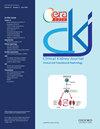同侧髂窝肾脏再移植:外科医生对围手术期结果的看法
IF 3.9
2区 医学
Q1 UROLOGY & NEPHROLOGY
引用次数: 0
摘要
背景 与初次移植相比,同侧肾脏再移植与手术并发症风险增加和移植物预后较差有关。本研究探讨了同侧再移植方法本身是否是手术并发症和早期移植物损失的独立风险因素。方法 在这项回顾性单中心分析中,比较了2007年1月至2017年12月同侧肾脏再移植与初次移植和对侧再移植的手术并发症和早期移植物预后。进行了单变量和多变量二元逻辑回归分析,以确定需要进行手术翻修的手术并发症和移植后第一年内移植物丢失的风险因素。结果 在1489例肾移植中,51例为同侧移植,159例为对侧再移植,1279例为初次移植。同侧和对侧再移植受者的基线特征除当前和最高 PRA 水平外没有差异。同侧再移植受者需要进行手术翻修的主要并发症明显多于初次移植受者(P = 0.010),但同侧再移植受者和对侧再移植受者之间没有差异(P = 0.217)。移植后第一年内,同侧再移植组的移植物丢失率为15.7%,对侧再移植组为8.8%(P = 0.163),而初次移植组为6.4%(P = 0.009)。在多变量回归模型中,同侧再移植未被确定为需要手术翻修的并发症或第一年移植物损失的独立风险因素。结论 同侧肾脏再移植不是导致不良结果的风险因素。将移植物植入移植前的髂窝是一种可行且有效的治疗方案。本文章由计算机程序翻译,如有差异,请以英文原文为准。
Kidney re-transplantation in the ipsilateral iliac fossa: a surgeon's perspective on perioperative outcome
Background Compared to primary transplantation, ipsilateral renal re-transplantation is associated with an increased risk of surgical complications and inferior graft outcomes. This study investigates whether an ipsilateral re-transplantation approach per se is an independent risk factor for surgical complications and early graft loss. Methods In this retrospective, single-centre analysis, surgical complications and early graft outcomes of ipsilateral kidney re-transplantations from January 2007 to December 2017 were compared with primary transplantations and contralateral re-transplantations. Univariate and multivariate binary logistic regression analyses were performed to identify risk factors for surgical complications requiring surgical revision and graft loss within the first year after transplantation. Results Of the 1.489 kidney transplantations, 51 were ipsilateral, 159 were contralateral re-transplantations, and 1.279 were primary transplantations. Baseline characteristics did not differ between the ipsilateral and contralateral re-transplant recipients except for current and highest PRA levels. Major complications requiring surgical revision were significantly more frequent in ipsilateral re-transplantations (P = 0.010) than in primary transplantations but did not differ between ipsilateral and contralateral re-transplantations (P = 0.217). Graft loss within the first year after transplant was 15.7% in the ipsilateral versus 8.8% in the contralateral re-transplant group (P = 0.163) versus 6.4% in the primary transplantation group (P = 0.009). In a multivariate regression model, ipsilateral re-transplantation was not identified as an independent risk factor for complications requiring surgical revision or first-year graft loss. Conclusions Ipsilateral renal re-transplantation is no risk factor for inferior outcomes. Graft implantation into a pre-transplanted iliac fossa is a feasible and valid therapeutic option.
求助全文
通过发布文献求助,成功后即可免费获取论文全文。
去求助
来源期刊

Clinical Kidney Journal
Medicine-Transplantation
CiteScore
6.70
自引率
10.90%
发文量
242
审稿时长
8 weeks
期刊介绍:
About the Journal
Clinical Kidney Journal: Clinical and Translational Nephrology (ckj), an official journal of the ERA-EDTA (European Renal Association-European Dialysis and Transplant Association), is a fully open access, online only journal publishing bimonthly. The journal is an essential educational and training resource integrating clinical, translational and educational research into clinical practice. ckj aims to contribute to a translational research culture among nephrologists and kidney pathologists that helps close the gap between basic researchers and practicing clinicians and promote sorely needed innovation in the Nephrology field. All research articles in this journal have undergone peer review.
 求助内容:
求助内容: 应助结果提醒方式:
应助结果提醒方式:


